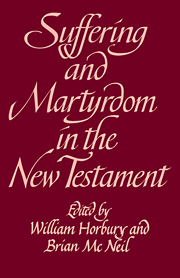 Suffering and Martyrdom in the New Testament
Suffering and Martyrdom in the New Testament Book contents
- Frontmatter
- Contents
- Abbreviations
- G. M. Styler and the Cambridge New Testament Seminar
- 1 Introduction
- 2 Did Jesus teach that his death would be vicarious as well as typical?
- 3 Imitatio Christi and the Lucan Passion narrative
- 4 The persecution of Christians in John 15: 18–16: 4a
- 5 Interchange and suffering
- 6 On the interpretation of Colossians 1: 24
- 7 Preparation for the perils of the last days: 1 Thessalonians 3:3
- 8 Maintaining the testimony of Jesus: the suffering of Christians in the Revelation of John
- 9 Martyrdom and inspiration
- 10 Suffering and martyrdom in the Odes of Solomon
- 11 Suffering and messianism in Yose ben Yose
- 12 What might martyrdom mean?
- Index of authors
- Index of references
- Index of subjects
1 - Introduction
Published online by Cambridge University Press: 26 February 2010
- Frontmatter
- Contents
- Abbreviations
- G. M. Styler and the Cambridge New Testament Seminar
- 1 Introduction
- 2 Did Jesus teach that his death would be vicarious as well as typical?
- 3 Imitatio Christi and the Lucan Passion narrative
- 4 The persecution of Christians in John 15: 18–16: 4a
- 5 Interchange and suffering
- 6 On the interpretation of Colossians 1: 24
- 7 Preparation for the perils of the last days: 1 Thessalonians 3:3
- 8 Maintaining the testimony of Jesus: the suffering of Christians in the Revelation of John
- 9 Martyrdom and inspiration
- 10 Suffering and martyrdom in the Odes of Solomon
- 11 Suffering and messianism in Yose ben Yose
- 12 What might martyrdom mean?
- Index of authors
- Index of references
- Index of subjects
Summary
Any and every ‘browser’ who picks up this book in a shop will find himself painfully involved in its subject, even if he totally repudiates the way in which it is handled in theology or in Christian devotion: inevitably – for suffering in some measure is the lot of us all, and innocent suffering is witnessed daily on television screens, while suffering bravely accepted because of one's convictions is never far from our consciousness. The question is what to do with suffering, and how to meet it.
Each of the contributors to this book studies some aspect of this theme, in the New Testament or in related literature. Added together, the essays present us with a spectrum that, within its chosen limits, is illuminating. How did Christians of the New Testament period interpret the sufferings of Jesus? How did they see the relation of their own sufferings to his? How much light is thrown on their own struggles and on their reflections on them by the way they present their story? How far does early Jewish and Christian literature subsequent to the New Testament period differ from or agree with New Testament thought? Finally, and urgently, by what processes may a modern reader interpret the mind of antiquity and come to grips with it in his own day?
Dr O'Neill holds that to interpret the death of Jesus as making its impact by no more than example (an ‘exemplarist’ theory of atonement) is alien to Jesus' own thinking. Jesus saw his death, he believes, as not merely exemplary but expiatory and vicarious – a service rendered to others that they could not do for themselves.
- Type
- Chapter
- Information
- Suffering and Martyrdom in the New TestamentStudies presented to G. M. Styler by the Cambridge New Testament Seminar, pp. 1 - 8Publisher: Cambridge University PressPrint publication year: 1981


